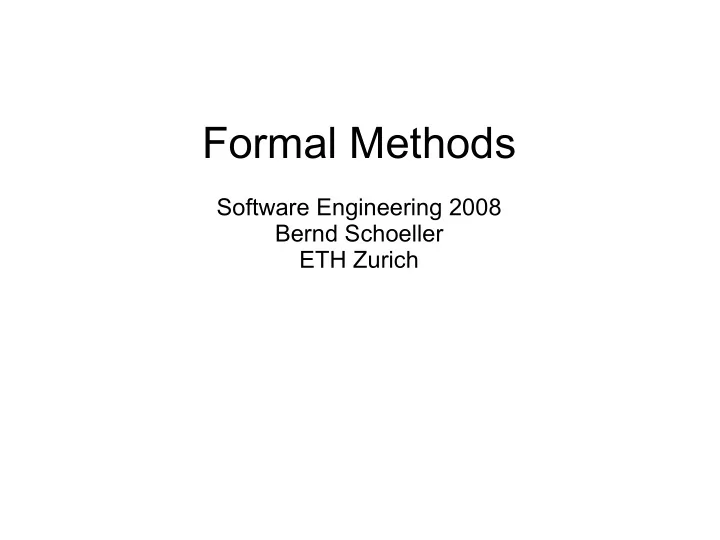

Formal Methods Software Engineering 2008 Bernd Schoeller ETH Zurich
The Grand Challenge The ideal of correct software has long been the goal of research in Computer Science. We now have a good theoretical understanding of how to describe what programs do, how they do it, and why they work. This understanding has already been applied to the design, development and manual verification of simple programs of moderate size that are used in critical applications. Automatic verification could greatly extend the benefits of this technology. [...] the time is ripe to embark on an international Grand Challenge project to construct a program verifier that would use logical proof to give an automatic check of the correctness of programs submitted to it. (Hoare and Misra, July 2005)
Lecture Contents ● Software verification overview – Bottom-up verification – Top-down verification ● Specification problems for verification – Specify what software does – Specify what software does not ● Tool demonstration – Rodin, Slam, (Spec#)
Proof Overview Specification Implementation Prover
Verification Problems ● State space explosion ● Combinatorial explosion ● Overall complexity ● Specification problems
Implementation vs. Specification Implementation Specification ● Concrete ● Abstract ● Constructive ● Descriptive ● Deterministic (mostly) ● Non-deterministic ● All is finite ● Can describe infinity ● Describes everything ● Describes only parts ● Can be executed by a ● Can not be executed machine by a machine
Bottom-Up Verification Implementation D Implementation C Implementation A Implementation B
Information Hiding Interface D Implementation D Interface C Implementation C Interface A Interface B Implementation A Implementation B
Modular verification Interface A Implementation A
Modular verification Interface B Implementation B
Modular verification Interface C Implementation C Interface A Interface B
Modular verification Interface D Implementation D Interface C Interface B
Assumption of System Correctness If each implementation is correct with respect to its interface, based on the interfaces of the modules it uses, then the overall system is correct.
Verification Technology ● Axiomatic Semantics – Hoare triples: {P} S {Q} – Weakest precondition computation ● Provers – Automatic (Simplify, Z3) – Interactive (Isabelle, COQ) – Model checking (blast, slam, ...)
The ideal specification too strong – implementation inefficient / impossible – difficult to change (information hiding) too weak – reasoning difficult for clients – not composable – side-effects: proofs impossible
Specification problems of Design by Contract Contracts on unbounded data Possible Solution: model-based contracts Frame problem Possible Solution: Dynamic Frame Contracts (DFC)
Unbound data class LINKED_QUEUE[G] feature put (v: G) -- Put `v' into the queue. ensure ? remove -- Remove the oldest element from the queue. ensure ? item: G -- Oldest element in the queue ensure ? end 17
Model-based contracts class LINKED_QUEUE[G] feature put (v: G) -- Put `v' into the queue. ensure model = old model.prepended (v) remove -- Remove the oldest element from the queue. ensure model = old model.front item: G -- Oldest element in the queue ensure Result = model.last model: MML_SEQUENCE[G] -- Contents of queue viewed as a sequence 18 end
Frame Problem ● You have a green box in Zürich and you want to have a red box in Luzern. Move Boxes Inc All-red Painters AG Specification : Give us the Specification : Give the Does it work? box and some money in box and some money, Zürich, and we will and we will change the transport the box to color of the box to red. Luzern within 2 days. 19
Frame Problem and DbC class PERSON feature -- Interface view last_name: STRING set_last_name (name: STRING) ensure last_name = name end class CIVIL_REGISTRY_OFFICE feature marry (first_person, second_person: PERSON) require first_person /= second_person do second_person.set_last_name (first_person.last_name) ensure first_person.last_name = second_person.last_name end end
Frames State FRAME A modify (“Set of (“write effect”) first_person. Resources”) last_name (query) second_person. set_last_name FRAME B use (“Set of (“read effect”) (command) Resources”) Resource can be: memory (fields), file, network state, ...
Hidden dependencies first_person second_person PERSON A PERSON B
Frame specifications strong specification weak specification class PERSON feature class PERSON feature -- Interface view -- Interface view last_name: STRING last_name: STRING use use { Current } personal_data set_last_name (name: STRING) set_last_name (name: STRING) ensure ensure last_name = name last_name = name modify modify { Current } personal_data end personal_data: FRAME end 23
Video Ballet Verifier 24
Top-Down Verification Specification 2. Specification 3. Specification 4. Specification Implementation
B Method ● Development by stepwise refinement ● Invented by J. R. Abrial (currently giving lectures at ETH!) ● Provers: Atelier B, B4Free, Rodin Platform ● Animator and Model Checker: ProB ● Industrial application: – Embedded devices – > 100000 LOC verified for the Paris Metro
Example: Traffic Light driveNS: BOOL driveEW: BOOL INVARIANT: not (driveNS and driveEW) EVENT: goNS := WHERE driveNS = FALSE THEN driveEW := TRUE END
Example: Traffic Light redLightNS,yellowLightNS,greenLightNS: BOOL redLightEW,yellowLightEW,greenLightEW: BOOL INV: greenLightNS = driveNS, greenLightEW = driveEW EVENT: goEW := WHERE redLightNS = FALSE THEN redLightEW, yellowLightEW, greenLightEW := FALSE,FALSE,TRUE END
Prove Obligations ● Within a machine, you have to prove: – That the initialization establishes the invariant – That each event re-establishes the invariant ● Within a refinement, you also have to prove – That the new initialization implies the old initialization – That refined events imply the old state change – That the new events refine SKIP
Demo Rodin Workbench
Problems with Top-Down Verification ● It is a mind-twister ● One needs to know all specifications from very early on ● Composition is difficult ● Reuse is very difficult ● Uncommon thinking ● Many common SE practice cannot be easily transfered: Information hiding, OO, pointers, ... But they are working on it, so keep your eyes open
Recommend
More recommend